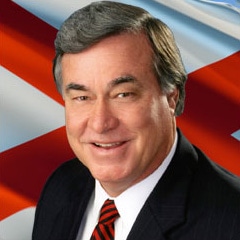Suppose you are some young person keenly interested in being Governor of Alabama one day. If that young person approached me and asked what would be the best course to take to capture that brass ring, my response would be that many times the best way to look into the future would be to study the past. Therefore, today I will share with you the historical paths taken to the governor’s office over the last century.
Over the past 100 years there could have been a total of 24 governors but George Wallace took four terms and Big Jim Folsom took two. Seventeen of the eighteen have been men. Eight have been lawyers by profession. Seven have been businessmen. Five of those seven have been very successful at business. We have had one farmer and one housewife/mother.
The most successful and proven route to governor has been to run for governor and lose but run second to the winner. Then immediately begin running for the next race four years later. You campaign for four full years building on the name identification you built in your first losing race. This worked repeatedly for the entire 20th century. However, this route has cooled since the law was amended to allow a governor to succeed themself and run for a second consecutive term. In addition, the advent of television has created a mechanism to achieve instant statewide name identification.
This route was called running a get acquainted race. You ran second and worked hard for four years then you were a shoe in or at least the favorite to win the next governor’s race. This was the way it was done from 1922 through 1962. During this 40-year period there were only nine different governors elected and six of those nine used the pattern of running the get acquainted race and coming back four years later to win. “Plain Bill” Brandon, Bibb Graves, Frank Dixon, Chauncey Sparks, “Big Jim” Folsom and George Wallace took the get acquainted journey.
Only seven of the eighteen ascended directly to governor from another political office. You would never guess what office over the last century has been the best stepping stone to the governor’s office. It has been the Public Service Commission. Three men have gone from the PSC to the governor’s office. However, this is somewhat misleading in that two of the three were some of the earliest governors in this summary. Braxton Bragg Comer was governor from 1907-1911 and Charles Henderson was in office from 1915-1919. Comer and Henderson were also two of the richest men to ever serve as governor and they served on the commission when it was called the Railroad Commission. They were more interested in regulating the railroads and utilities to protect their business interests than striving for political acclaim. This was also true for their interest in being governor. They looked upon being governor as a civic tour of duty while amassing their vast business empire. Gordon Persons, a Montgomery businessman, was the last of the three to move from the PSC to governor in 1950.
The second most popular stepping stone has been lieutenant governor. However, only two of eighteen have moved up from this post, Thomas Kilby in 1918 and Don Siegelman in 1998. There has been one attorney general, John Patterson, in 1958 and only one congressman, our current Governor Bob Riley.
Out of the eight lawyers, four were known primarily as politicians who had law degrees. However, four were very prominent and skilled attorneys. Two came out of the blue to be elected governor with only their prominence in the law on their resume.
In recent history three men have bolted out of the blue to be elected governor with no state political experience. Big Jim Folsom and Fob James, had never been elected to any office prior to governor. Guy Hunt had only been Probate Judge. Two of our former governors, Folsom and Hunt, came from Cullman County.
So there you have it. If you are a young aspiring politician, take this historical data and run with it and good luck.
See you next week.

Steve Flowers
Alabama’s premier columnist and commentator, Steve has analyzed Alabama politics for national television audiences on CBS, PBS, ABC and the British Broadcasting Network. Steve has been an up close participant and observer of the Alabama political scene for more than 50 years and is generally considered the ultimate authority on Alabama politics and Alabama political history.